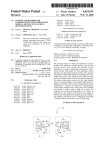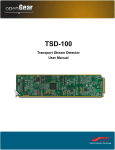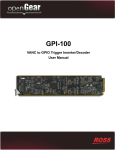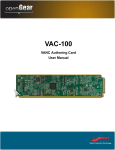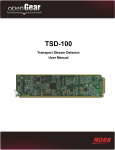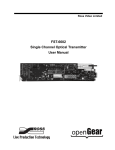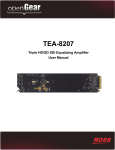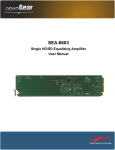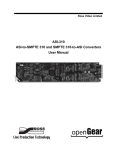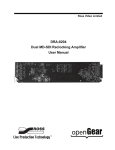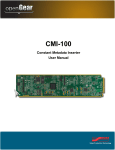Download VDD-100 User Manual
Transcript
VDD-100 VANC Data Decoder User Manual VDD-100 User Manual • Ross Part Number: VDD100DR-004-04 • Release Date: May 10, 2012. The information in this manual is subject to change without notice or obligation. Copyright © 2012 Ross Video Limited. All rights reserved. Contents of this publication may not be reproduced in any form without the written permission of Ross Video Limited. Reproduction or reverse engineering of copyrighted software is prohibited. Patents This product is protected by the following US Patents: 4,205,346; 5,115,314; 5,280,346; 5,561,404; 7,304,886; 7,508,455; 7,602,446; 7,834,886; 7,914,332. This product is protected by the following Canadian Patents: 2039277; 1237518; 1127289. Other patents pending. Notice The material in this manual is furnished for informational use only. It is subject to change without notice and should not be construed as commitment by Ross Video Limited. Ross Video Limited assumes no responsibility or liability for errors or inaccuracies that may appear in this manual. Trademarks • is a registered trademark of Ross Video Limited. • Ross, ROSS, ROSS®, and MLE are registered trademarks of Ross Video Limited. • openGear® is a registered trademark of Ross Video Limited. • DashBoard Control System™ is a trademark of Ross Video Limited. • All other product names and any registered and unregistered trademarks mentioned in this manual are used for identification purposes only and remain the exclusive property of their respective owners. Important Regulatory and Safety Notices to Service Personnel Before using this product and nay associated equipment, refer to the “Important Safety Instructions” listed below to avoid personnel injury and to prevent product damage. Product may require specific equipment, and/or installation procedures to be carried out to satisfy certain regulatory compliance requirements. Notices have been included in this publication to call attention to these specific requirements. Symbol Meanings This symbol on the equipment refers you to important operating and maintenance (servicing) instructions within the Product Manual Documentation. Failure to heed this information may present a major risk of damage to persons or equipment. Warning — The symbol with the word “Warning” within the equipment manual indicates a potentially hazardous situation, which, if not avoided, could result in death or serious injury. Caution — The symbol with the word “Caution” within the equipment manual indicates a potentially hazardous situation, which, if not avoided, may result in minor or moderate injury. It may also be used to alert against unsafe practices. Notice — The symbol with the word “Notice” within the equipment manual indicates a potentially hazardous situation, which, if not avoided, may result in major or minor equipment damage or a situation which could place the equipment in a non-compliant operating state. ESD Susceptibility — This symbol is used to alert the user that an electrical or electronic device or assembly is susceptible to damage from an ESD event. Important Safety Instructions Caution — This product is intended to be a component product of the DFR-8300 series frame. Refer to the DFR-8300 Series Frame User Manual for important safety instructions regarding the proper installation and safe operation of the frame as well as its component products. Warning — Certain parts of this equipment namely the power supply area still present a safety hazard, with the power switch in the OFF position. To avoid electrical shock, disconnect all A/C power cords from the chassis’ rear appliance connectors before servicing this area. Warning — Service barriers within this product are intended to protect the operator and service personnel from hazardous voltages. For continued safety, replace all barriers after any servicing. This product contains safety critical parts, which if incorrectly replaced may present a risk of fire or electrical shock. Components contained with the product’s power supplies and power supply area, are not intended to be customer serviced and should be returned to the factory for repair. To reduce the risk of fire, replacement fuses must be the same time and rating. Only use attachments/accessories specified by the manufacturer. EMC Notices United States of America FCC Part 15 This equipment has been tested and found to comply with the limits for a class A Digital device, pursuant to part 15 of the FCC Rules. These limits are designed to provide reasonable protection against harmful interference when the equipment is operated in a commercial environment. This equipment generates, uses, and can radiate radio frequency energy and, if not installed and used in accordance with the instruction manual, may cause harmful interference to radio communications. Operation of this equipment in a residential area is likely to cause harmful interference in which case the user will be required to correct the interference at their own expense. Notice — Changes or modifications to this equipment not expressly approved by Ross Video Limited could void the user’s authority to operate this equipment. CANADA This Class “A” digital apparatus complies with Canadian ICES-003. Cet appariel numerique de la classe “A” est conforme a la norme NMB-003 du Canada. EUROPE This equipment is in compliance with the essential requirements and other relevant provisions of CE Directive 93/68/EEC. INTERNATIONAL This equipment has been tested to CISPR 22:1997 along with amendments A1:2000 and A2:2002, and found to comply with the limits for a Class A Digital device. Notice — This is a Class A product. In domestic environments, this product may cause radio interference, in which case the user may have to take adequate measures. Maintenance/User Serviceable Parts Routine maintenance to this openGear product is not required. This product contains no user serviceable parts. If the module does not appear to be working properly, please contact Technical Support using the numbers listed under the “Contact Us” section on the last page of this manual. All openGear products are covered by a generous 5-year warranty and will be repaired without charge for materials or labor within this period. See the “Warranty and Repair Policy” section in this manual for details. Environmental Information The equipment that you purchased required the extraction and use of natural resources for its production. It may contain hazardous substances that could impact health and the environment. To avoid the potential release of those substances into the environment and to diminish the need for the extraction of natural resources, Ross Video encourages you to use the appropriate take-back systems. These systems will reuse or recycle most of the materials from your end-of-life equipment in an environmentally friendly and health conscious manner. The crossed out wheelie bin symbol invites you to use these systems. If you need more information on the collection, re-use, and recycling systems, please contact your local or regional waste administration. You can also contact Ross Video for more information on the environmental performance of our products. Company Address Ross Video Limited Ross Video Incorporated 8 John Street P.O. Box 880 Iroquois, Ontario, K0E 1K0 Ogdensburg, New York Canada USA 13669-0880 General Business Office: (+1) 613 • 652 • 4886 Fax: (+1) 613 • 652 • 4425 Technical Support: (+1) 613 • 652 • 4886 After Hours Emergency: (+1) 613 • 349 • 0006 E-mail (Technical Support): [email protected] E-mail (General Information): [email protected] Website: http://www.rossvideo.com Contents Introduction 1 Overview.............................................................................................................................. 1-2 Features.................................................................................................................. 1-2 Functional Block Diagram................................................................................................... 1-3 User Interfaces ..................................................................................................................... 1-4 DashBoard Control System™ ............................................................................... 1-4 SNMP Monitoring and Control ............................................................................. 1-4 Documentation Terms and Conventions.............................................................................. 1-5 Installation 2 Before You Begin ................................................................................................................ 2-2 Static Discharge..................................................................................................... 2-2 Unpacking.............................................................................................................. 2-2 Quick Start ........................................................................................................................... 2-3 Installing the VDD-100 ....................................................................................................... 2-4 Rear Modules for the VDD-100 ............................................................................ 2-4 Installing a Rear Module ....................................................................................... 2-4 Installing the VDD-100 ......................................................................................... 2-5 Cabling for the VDD-100 .................................................................................................... 2-6 Rear Module Cabling Overview............................................................................ 2-6 Connections Overview .......................................................................................... 2-6 Software Upgrades............................................................................................................... 2-8 User Controls 3 Card Overview ..................................................................................................................... 3-2 Control and Monitoring Features......................................................................................... 3-3 Status and Selection LEDs on the VDD-100 ........................................................ 3-3 Configuration 4 General Settings ................................................................................................................... 4-2 Enabling the GPIOs ............................................................................................................. 4-3 Enabling the GPIOs............................................................................................... 4-3 Setting the GPIO Level ......................................................................................... 4-3 Setting DID/SDIDs .............................................................................................................. 4-4 Capturing a Packet ............................................................................................................... 4-5 Entering Data Matching Strings .......................................................................................... 4-6 Entering Data Mask Strings ................................................................................................. 4-8 Setting the Hold Times ........................................................................................................ 4-9 Monitoring ......................................................................................................................... 4-10 Monitoring using DashBoard .............................................................................. 4-10 Specifications 5 Technical Specifications ...................................................................................................... 5-2 VDD-100 User Manual (Iss. 04) Contents • i Service Information 6 Troubleshooting Checklist ................................................................................................... 6-2 Reset Button........................................................................................................... 6-2 Warranty and Repair Policy ................................................................................................. 6-3 ii • Contents VDD-100 User Manual (Iss. 04) Introduction In This Chapter This chapter contains the following sections: • Overview • Functional Block Diagram • User Interfaces • Documentation Terms and Conventions A Word of Thanks Congratulations on choosing an openGear VDD-100 VANC Data Decoder. Your VDD-100 is part of a full line of Digital Products within the openGear Terminal Equipment family of products, backed by Ross Video’s experience in engineering and design expertise since 1974. You will be pleased at how easily your new VDD-100 fits into your overall working environment. Equally pleasing is the product quality, reliability and functionality. Thank you for joining the group of worldwide satisfied Ross Video customers! Should you have a question pertaining to the installation or operation of your VDD-100, please contact us at the numbers listed on the back cover of this manual. Our technical support staff is always available for consultation, training, or service. VDD-100 User Manual (Iss. 04) Introduction • 1–1 Overview The VDD-100 extracts packets from the Vertical Ancillary (VANC) data area of a video signal and closes GPIO contacts when they match user supplied strings. TheVDD-100 detects VANC services such as AFD, Branding Triggers, SCTE 104, and others. The VDD-100 can monitor up to eight different DID/SDID combinations for matching data. Features The following features make the VDD-100 an ideal solution for detection of VANC services: 1–2 • Introduction • Operates automatically with popular SD and HD video formats • Detects specific values of AFD and close GPIO contacts to control equipment such as keyers or up/down/cross converters • Detects specific values of branding triggers and close GPIO contacts to control logo insertion equipment • Ability to parse incoming SCTE 104 triggers and set the GPIO accordingly • Flexible matching allows detection of a wide variety of VANC data patterns and control of any equipment that can react to a contact closure • Frame-accurate triggering: each trigger is delivered within one video frame time • Reports status and can be configured remotely via the DashBoard Control System™ • Compatible with DataSafe™ • Fits openGear DFR-8300 series frames • Fully compliant with openGear specifications • 5-year transferable warranty VDD-100 User Manual (Iss. 04) Functional Block Diagram This section provides the functional block diagram that outlines the workflow of the VDD-100. HD/SD-SDI OUT HD/SD-SDI IN EQUALIZE/ DESERIALIZE SERIALIZE HD/SD-SDI MON OUT EXTRACT VANC CPU RELAYS GPIOs Figure 1.1 Simplified Block Diagram — VDD-100 VDD-100 User Manual (Iss. 04) Introduction • 1–3 User Interfaces The VDD-100 provides two user interfaces for controlling and monitoring the VDD-100. DashBoard Control System™ The DashBoard Control System™ enables you to monitor and control openGear frames and cards from a computer. DashBoard communicates with other cards in the DFR-8300 series frame through the MFC-8300 Series Network Controller Card. For More Information... • on using DashBoard, refer to the DashBoard User Manual. SNMP Monitoring and Control The MFC-8300 Series Network Controller Card in the DFR-8300 series frame provides optional support for remote monitoring of your frame and the using Simple Network Management Protocol (SNMP), which is compatible with many third-party monitoring and control tools. For More Information... 1–4 • Introduction • on the SNMP controls for the VDD-100, refer to the VDD-100 Management Information Base (MIB) file. • SNMP monitoring, refer to the MFC-8300 Series User Manual. VDD-100 User Manual (Iss. 04) Documentation Terms and Conventions The following terms and conventions are used throughout this manual: • “Board”, and “Card” refer to openGear terminal devices within openGear frames, including all components and switches. • “DashBoard” refers to the DashBoard Control System™. • “DFR-8300 series frame” refers to all versions of the 10-slot (DFR-8310 series frames), the 20-slot (DFR-8321 series frames) and any available options unless otherwise noted. • “Frame” refers to DFR-8300 series frame that houses the VDD-100 card, as well as any openGear frames. • “GPIO” refers to the DC signals used by one device to control another (General Purpose Input-Output). • “Operator” and “User” refer to the person who uses VDD-100. • “System” and “Video system” refer to the mix of interconnected production and terminal equipment in your environment. • “VANC” refers to the Vertical Ancillary Data space of a serial digital video signal, and is defined by SMPTE-291M. • The “Operating Tips” and “Note” boxes are used throughout this manual to provide additional user information. VDD-100 User Manual (Iss. 04) Introduction • 1–5 1–6 • Introduction VDD-100 User Manual (Iss. 04) Installation In This Chapter This chapter provides instructions for installing the VDD-100, installing the card into the frame, cabling details, and updating the card software. The following topics are discussed: • Before You Begin • Quick Start • Installing the VDD-100 • Cabling for the VDD-100 • Software Upgrades VDD-100 User Manual (Iss. 04) Installation • 2–1 Before You Begin Before proceeding with the instructions in this chapter, ensure that your DFR-8300 series frame is properly installed according to the instructions in the DFR-8300 Series User Manual. Static Discharge Throughout this chapter, please heed the following cautionary note: ESD Susceptibility — Static discharge can cause serious damage to sensitive semiconductor devices. Avoid handling circuit boards in high static environments such as carpeted areas and when synthetic fiber clothing is worn. Always exercise proper grounding precautions when working on circuit boards and related equipment. Unpacking Unpack each VDD-100 you received from the shipping container and ensure that all items are included. If any items are missing or damaged, contact your sales representative or Ross Video directly. 2–2 • Installation VDD-100 User Manual (Iss. 04) Quick Start Assuming you have an openGear frame, a VDD-100 card and a suitable rear module, the following steps will allow you to start matching VANC packets: 1. Connect the frame to your LAN. Refer to the DFR-8300 Series User Manual and the MFC-8300 Series User Manual for details. 2. Install DashBoard on a computer connected to the LAN. The DashBoard Control System™ software and user manual is available from the Ross Video website. 3. Install a rear module in the frame, as described in the section “Installing a Rear Module” on page 2-4. 4. Install a VDD-100 into the rear module, as described in the section “Installing the VDD-100” on page 2-5. 5. Connect a 292 or 259 video signal to the SDI input jack on the rear module of the encode card as described in the section “Cabling for the VDD-100” on page 2-6. 6. Launch the DashBoard client on your computer. It should automatically find your frame within a minute or two. 7. Expand the node for the frame that you installed the VDD-100. A list of cards in the frame is displayed. 8. Double-click the node for the VDD-100 you wish to configure for encoding. A tab for the card displays in the Device View of the DashBoard client. 9. Select the DID / SDID Settings tab and set the DID and SDID values for the GPIOs that will be used. Click Save to make this change. For example, SMPTE 2016-3 specifies that AFD has DID=41h (65 decimal) and SDID=05h. If you want to assign GPIO 1 to AFD, you would enter these numbers into the fields next to GPIO 1. 10. Select the Packet Capture tab and select the GPIOs that will be used. Click Capture. Click Copy. Repeat as required. 11. If you are using SCTE 104 triggers, follow the steps in the “To set a matching string when using SCTE 104 triggers:” on page 4-6 to complete this procedure and skip the remaining steps. 12. Select the GPIO Data Matching tab and modify the matching strings for the GPIOs that will be used. • Set the GPIO matching string to modify. • Set the length of the match string and indicate whether the packet length must match the match string length. • Set the string bytes one at a time, verifying contents in the string display windows on the GPIO Data Matching tab. For example, the AFD packet for a 16:9 center cut in 8 bytes long as shown in the image on the right. 13. Select the GPIO Matching Mask tab and set up the mask strings to apply to any incoming data. For example, to match on the AFD code and to ignore the bar data, the mask should be set as follows: • Set the GPIO mask string to modify by entering the value in the GPIO field. • Enter the mask bytes one at a time, in the Byte to Change and Value fields, verifying the results in the read-only field of the tab. 14. Connect the GPIO outputs to the devices they will be triggering. 15. Verify the GPIOs are triggering when the specified VANC data is present. VDD-100 User Manual (Iss. 04) Installation • 2–3 Installing the VDD-100 This section outlines how to install a rear module and a card in a DFR-8300 series frame. Rear Modules for the VDD-100 When installing the VDD-100 in the DFR-8300 series frames, use the following rear modules: • DFR-8310 series frame — The MDL-R02 Full Rear Module is required. The VDD-100 is not compatible with the DFR-8310-BNC frames. • DFR-8321 series frame — The MDL-R22 Full Rear Module is required. Installing a Rear Module If the Rear Module is already installed, proceed to the section “Installing the VDD-100” on page 2-5. Use the following procedure to install a Rear Module in your DFR-8300 series frame: 1. Locate the card frame slots on the rear of the frame. 2. Remove the Blank Plate from the slot you have chosen for the VDD-100 installation. 3. Install the bottom of the Rear Module in the Module Seating Slot at the base of the frame’s back plane.(Figure 2.1) Screw Hole Module Seating Slot Figure 2.1 Rear Module Installation in a DFR-8300 Series Frame (VDD-100 not shown) 4. Align the top hole of the Rear Module with the screw on the top-edge of the frame back plane. 5. Using a Phillips screwdriver and the supplied screw, fasten the Rear Module to the back plane of the frame. Do not over tighten. 6. Ensure proper frame cooling and ventilation by having all rear frame slots covered with Rear Modules or Blank Plates. 2–4 • Installation VDD-100 User Manual (Iss. 04) Installing the VDD-100 Use the following procedure to install the VDD-100 in a DFR-8300 series frame: 1. Locate the Rear Module you installed in the procedure “Installing a Rear Module” on page 2-4. Notice — Heat and power distribution requirements within a frame may dictate specific slot placements of cards. Cards with many heat-producing components should be arranged to avoid areas of excess heat build-up, particularly in frames using convectional cooling. 2. Hold the VDD-100 by the edges and carefully align the card-edges with the slots in the frame. 3. Fully insert the card into the frame until the rear connection plus is properly seated in the Rear Module. 4. Verify whether your rear module label is self-adhesive by checking the back of the label for a thin wax sheet. You must remove this wax sheet before affixing the label. 5. Affix the supplied rear module label to the BNC area of the Rear Module. VDD-100 User Manual (Iss. 04) Installation • 2–5 Cabling for the VDD-100 This section provides information for connecting cables to the installed Rear Modules on the DFR-8300 series frames. Rear Module Cabling Overview This section summarizes the cabling designations for the VDD-100. Connect the input and output cables according to the following sections. DFR-8310 Series Frames In the DFR-8310 series frames, the VDD-100 is used with the MDL-R02. Each module occupies one slot and accommodates one card. This rear module provides one SDI input, one video output, a monitoring output, and relay-isolated GPIO outputs. (Figure 2.2) DFR-8321 Series Frames In the DFR-8321 series frames, the VDD-100 is used with the MDL-R22. Each module occupies two slots and accommodates one card. This rear module provides one SDI input, one video output, a monitoring output, and relay-isolated GPIO outputs. (Figure 2.2) HD/SD-SDI In HD/SD-SDI Out GPIOs 1 2 HD/SD-SDI MON Out Not connected 3 4 GPIOs Figure 2.2 Cabling for the MDL-R02 and MDL-R22 Rear Modules Connections Overview This section briefly outlines the types of connections available on the rear modules. HD/SD-SDI In — BNC 1 BNC 1 accepts an SDI (SMPTE 259) or HD-SDI (SMPTE 292) video signal. The VDD-100 requires this input in all cases. It extracts VANC packets from this signal and routes the resulting output to BNC 3. The input signal is internally terminated in 75ohms when the VDD-100 is active. 2–6 • Installation VDD-100 User Manual (Iss. 04) HD/SD-SDI Monitoring Out — BNC 2 BNC 2 carries a copy of the SDI output present on BNC 3 when the VDD-100 is active. This can be useful for test purposes. This BNC does not have any bypass capability: with power off or the VDD-100 removed, there is no output signal on this jack. HD/SD-SDI Out — BNC 3 BNC 3 carries the main program output from the VDD-100, consisting of a reclocked copy of the signal applied to BNC 1. GPIOs GPIO 1-8 carry the output from the VDD-100 triggered when incoming data matches the user supplied match string. The rear modules provide relay contact between 1A and 1B, 2A and 2B, and so on. Refer to Figure 2.3 for MDL-R02 pinouts and Figure 2.4 for MDL-R22 pinouts. 5A 5B 6A 6B 7A 7B 8A 8B 1A 1B 2A 2B 3A 3B 4A 4B Figure 2.3 GPIO Pinouts for the MDL-R02 Rear Module VDD-100 User Manual (Iss. 04) 1A 1B 2A 2B 3A 3B 4A 4B 5A 5B 6A 6B 7A 7B 8A 8B Figure 2.4 GPIO Pinouts for the MDL-R22 Rear Module Installation • 2–7 Software Upgrades This section provides instructions for upgrading the software for your VDD-100 using the DashBoard Control System™. Use the following procedure to upgrade the software on a VDD-100: 1. Contact Ross Technical Support for the latest software version file. 2. Launch the DashBoard client on your computer. 3. Display a tab for the card you wish to upgrade by double-clicking its status indicator in the Basic Tree View. 4. From the Device tab, click Upload to display the Select File for upload dialog box. 5. Navigate to the *.bin upload file you wish to upload. 6. Click Open and follow the on-screen instructions. 7. Click Finish to start the upgrade. 8. Monitor the upgrade. • A Upload Status dialog enables you to monitor the upgrade process. • The card reboots automatically once the file is uploaded. The card is temporarily taken offline. • The reboot process is complete once the status indicators for the Card State and Connection return to their previous status. Operating Tip — If you are running DashBoard version 2.3.0 or lower, you must click Reboot in the Device tab to complete the upgrade process. This completes the procedure for upgrading the software on a VDD-100. Troubleshooting If you encounter problems when upgrading your card software, verify the following: 2–8 • Installation • Ethernet cable is properly connected if you are uploading the file via a network connection. • The file you are attempting to load is a *.bin file that is for the card you are upgrading. VDD-100 User Manual (Iss. 04) User Controls In This Chapter This chapter provides a general overview of the user controls available on the VDD-100. The following topics are discussed: • Card Overview • Control and Monitoring Features VDD-100 User Manual (Iss. 04) User Controls • 3–1 Card Overview This section provides a general overview of the VDD-100 card components. 1 2 3 Figure 3.1 VDD-100 — Components 1) Bypass Switch (SW1) 2) Menu Switch (SW2) 3) Reset Switch (SW3) 1. Bypass Switch (SW1) If the VDD-100 is installed in a rear module that has a bypass relay, this two-position push-button is used to control the relay. • When the push-button is in the IN position, the VDD-100 is in the video signal path. In the recommended MDL-R22 and MDL-R02 Full Rear Modules, the SW1 should be left in the IN position at all times. • Pressing the button once moves the switch to the OUT position and bypasses the VDD-100. • Pressing the button again restores the VDD-100 to its active state. 2. Menu Switch (SW2) This switch is not implemented on the VDD-100. 3. Reset Switch (SW3) This button is used for rebooting the card. Refer to the section “Reset Button” on page 6-2 for details on using this button. For More Information... • 3–2 • User Controls on the LEDs available on the card-edge, refer to the section “Control and Monitoring Features” on page 3-3. VDD-100 User Manual (Iss. 04) Control and Monitoring Features This section provides information on the card-edge LEDs for the VDD-100. Refer to Figure 3.2 for the location of the LEDs. POWER LED (DS1) BYPASS LED (DS2) Bypass Switch (SW1) PGM VIDEO IN LED (DS3) PGM VIDO OUT LED (DS4) DS5 LED DS6 LED Menu Switch (SW2) DS7 LED DS8 LED VIDEO ERROR LED (DS9) UNKNOWN REAR MODULE LED (DS10) DS11 LED DS12 LED Reset Button (SW3) Figure 3.2 VDD-100 Card-edge Controls Status and Selection LEDs on the VDD-100 The front-edge of the VDD-100 has LED indicators for communication activity. Basic LED displays and descriptions are provided in Table 3.1. Table 3.1 LEDs on the VDD-100 LED POWER (DS1) BYPASS (DS2) VDD-100 User Manual (Iss. 04) Color Display and Description Green When lit green, this LED indicates the card is operating with a valid input. Flashing Green When flashing green, this LED indicates the bootloader is waiting for a software upload. Orange When lit orange, this LED indicates this is a warning about a signal or configuration error. Red When lit red, this LED indicates that the card is not operational. This will occur if, for example, there is no video input. Off When off, this LED indicates there is no power to the card. Red When lit red, this LED indicates the card is in bypass mode. Off When off, this LED indicates the card is in the video path and is capable of inserting data. User Controls • 3–3 Table 3.1 LEDs on the VDD-100 LED PGM VID IN (DS3) PGM VID OUT (DS4) Color Green When lit green, this LED indicates the Program Video input is present and valid. Red When lit red, this LED indicates that no valid input is present. Ensure that the input cable is connected properly to the rear module. Green When lit green, this LED indicates the Program Video output serializer is locked to a valid input. Red When lit red, this LED indicates there is hardware fault on the card. These LEDs are not defined. DS5-8 VID ERROR (DS9) UNKNOWN REAR MODULE (DS10) DS11-12 3–4 • User Controls Display and Description Green When lit green, this LED indicates that no video errors are occurring. Orange When lit orange, this LED indicates that there is an error condition occurring (e.g. EDH) in the video input stream. Green When lit green, this LED indicates the card is installed with a valid rear module. Orange When lit orange, this LED indicates that the rear module connected to the card is not one of the types recognized by the software. Operation may not be correct. These LEDs are not defined. VDD-100 User Manual (Iss. 04) Configuration In This Chapter This chapter explains how to use the user interface to set up the VDD-100. This discussion is based on the use of DashBoard through a network connection. The following topics are discussed: • General Settings • Enabling the GPIOs • Setting DID/SDIDs • Capturing a Packet • Entering Data Matching Strings • Entering Data Mask Strings • Setting the Hold Times • Monitoring VDD-100 User Manual (Iss. 04) Configuration • 4–1 General Settings Before proceeding to any of the other sections, please ensure that these settings are correct, as they will have an effect on the operation of the other functions. Assigning a unique name to each card is especially useful if you have more than one VDD-100 in a frame. Naming each GPIO output is useful for reminding the user what device is attached to the GPIO. The names you assign display in the various tabs and fields for the card. To assign names to the card and the GPIOs: 1. Launch the DashBoard client on your computer. 2. Display a tab in the Device View for the card you wish to configure. 3. From the Device View, select the Settings tab. 4. Type a unique name for the VDD-100 card in the Card Name field (up to 15 characters). If this field is left blank, the card is automatically named VDD-100. 5. Type a unique name for each GPIO output in the specific GPIO (#) Name field. If this field were blank, the GPIO output is automatically named after its connector placement on the rear module. 6. Click Apply. It is important to click this button before moving to another tab or the changes will not be made. 4–2 • Configuration VDD-100 User Manual (Iss. 04) Enabling the GPIOs The VDD-100 has eight GPIOs that a user can configure for triggering. Enabling the GPIOs The GPIO Enable tab controls which of the eight are active. While decoding data packets from the VANC, the VDD-100 will only drive GPIOs that are checked. Normally, an active GPIO closes the contact between the two pins. To enable the GPIOs for your card: 1. Display a tab in the Device View of DashBoard for the card you wish to configure. 2. From the Device View, select the GPIO Enable tab. 3. To enable a GPIO, select the check box associated with the specific GPIO you wish the card to drive. 4. Click Save to apply your changes. Setting the GPIO Level Use the options in the GPIO Polarity tab if you want the contacts to close when the GPIO is active. To set the GPIO level: 1. Display a tab in the Device View of DashBoard for the card you wish to configure. 2. Select the GPIO Polarity tab. 3. To have the contacts close when the GPIO is active, select the corresponding check box for that GPIO. 4. To have an active GPIO open the contact between the two pins, clear the corresponding check box for that GPIO. 5. Click Save to apply your changes. VDD-100 User Manual (Iss. 04) Configuration • 4–3 Setting DID/SDIDs The VDD-100 can monitor a separate DID and SDID for each of its eight GPIOs. The DID / SDID Settings tab allows the user to set the DID and SDID value for each of the GPIOs. To set the DID and SDID for a GPIO: 1. Display a tab in the Device View of DashBoard for the card you wish to configure. 2. From the Device View, select the DID/SDID Settings tab. 3. Fill in a DID and SDID value in the boxes to the right of the GPIO number. • DID — Input the values according to the specifications. • SDID — Input the values according to the specifications. 4. Click Save to apply your changes. 4–4 • Configuration VDD-100 User Manual (Iss. 04) Capturing a Packet The VDD-100 includes a feature for capturing data in the ANC packets, sorted by DID and SDID, passed when a specific GPIO is triggered. The packet information is then displayed in the Captured Data field of the Packet Capture tab. To capture a packet: 1. Display a tab in the Device View of DashBoard for the card you wish to configure. 2. Set the DID and SDID as outlined in the section “To set the DID and SDID for a GPIO:” on page 4-4. 3. Select the Packet Capture tab. 4. Specify a GPIO using the GPIO field. This is the same GPIO you selected in step 2. 5. Click Capture Data. • The VDD-100 captures the next data packet that matches the DID/SDID for the GPIO you selected. • The Captured Data field is updated with the captured packet information. 6. To copy the captured packet into the matching string for the selected GPIO: • Click Copy Data in the Packet Capture tab. • The GPIO field in the corresponding tab of the GPIO Data Matching tab is also updated with the packet information. • Note that the matching string is the one selected in the GPIO Data Matching tab. 7. Proceed to the section “Entering Data Matching Strings” on page 4-6. VDD-100 User Manual (Iss. 04) Configuration • 4–5 Entering Data Matching Strings The VDD-100 allows you to set a different data matching string for each of its eight GPIOs. If you find the VANC packet you are examining contains data that is non-static (such as a counter), the VDD-100 allows you to ignore those bits / bytes using a data mask described in the section “Entering Data Mask Strings” on page 4-8. To set a matching string: 1. Display a tab in the Device View of DashBoard for the card you wish to configure. 2. Select the GPIO Data Matching tab. 3. Select the sub-tab for the specific GPIO you wish to configure. 4. Type a value in the Length field to select the length of the match string you are entering. Note — Setting the Length to zero (0) clears the matching string. 5. Select the incoming length using the Match Type menu. Choose from the following: • LEN — Select this option when the length of the incoming must match the matching string. • ANY — Select this option to ignore the incoming length and just match on the bytes supplied. 6. Click Save. The change is reflected in the GPIO match string fields. 7. Select the byte number you wish to alter in the Byte to Change field and supply a byte to match on in the Value field. 8. Click Save. The change is reflected in the GPIO match string fields. 9. Repeat the procedure for each GPIO you wish to configure. To set a matching string when using SCTE 104 triggers: 1. Display a tab in the Device View of DashBoard for the card you wish to configure. 2. Select the GPIO Data Matching tab. 3. Select the sub-tab for the specific GPIO you wish to configure. 4. Select the Use SCTE 104 decoding box. Note — The GPIO Matching Masks tab settings and the remaining GPIO Data Matching tab settings are not applicable when the Use SCTE 104 decoding box is selected. 5. To match the Program ID in the trigger: • Select the Match Program ID box. • Use the Program ID field to specify the Program ID value that the VDD-100 searches for in the trigger. The VDD-100 activates the GPIO when the specified value matches what is set in the trigger. If the values do not match, the trigger is ignored. 6. To match the Splice ID in the trigger: • 4–6 • Configuration Select the Match Splice ID box. VDD-100 User Manual (Iss. 04) • Use the Splice ID field to specify the Splice ID value that the VDD-100 searches for in the trigger. The VDD-100 activates the GPIO when the specified value matches what is set in the trigger. If the values do not match, the trigger is ignored. 7. Select the Ignore Pre-roll box to enable the VDD-100 to ignore any pre-roll values and initiate the trigger immediately. 8. Use the Trigger Delay slider to augment when the pre-roll begins (in milliseconds). A negative value decreases the pre-roll start time while a positive value adds to the pre-roll start time. The default Trigger Delay is zero (0) and its setting limited to reducing the pre-roll start time to zero (0). VDD-100 User Manual (Iss. 04) Configuration • 4–7 Entering Data Mask Strings The VDD-100 allows the user to set matching strings for each of its eight GPIOs. However, sometimes it's desirable to ignore certain bytes or bits when matching. For example, some bytes may have unknown or changing values. To set a mask string: 1. Display a tab in the Device View of DashBoard for the card you wish to configure. 2. Select the GPIO Matching Masks tab. 3. Select the sub-tab for the specific GPIO you wish to configure. 4. Select the byte number you wish to alter and supply a 8 bit hex mask byte. This has 1 in each bit that is to be used in matching, and 0 in each bit that is to be ignored. 5. Click Save. The change is reflected in the GPIO Matching tabs. 6. Repeat the procedure for each GPIO you wish to configure. 4–8 • Configuration VDD-100 User Manual (Iss. 04) Setting the Hold Times The VDD-100 allows the user to adjust the hold times for each of its eight GPIOs. When a GPIO is triggered by the detection of a specified data pattern in VANC it will remain asserted for the number of seconds specified in the GPIO Hold Time tab. To set the hold time: 1. Display a tab in the Device View of DashBoard for the card you wish to configure. 2. Select the GPIO Hold Time tab. 3. In the field for the specific GPIO you wish to configure the hold time for, enter a value (seconds) for the Hold Time. Note that when this value is set to 0, the GPIO is asserted as long as the data pattern is present. 4. Repeat the procedure for each GPIO you wish to configure. 5. Click Save to apply your changes. VDD-100 User Manual (Iss. 04) Configuration • 4–9 Monitoring This section provides a summary of the status fields available when using DashBoard to monitor the VDD-100. Monitoring using DashBoard The Status tabs provide read-only information such as software revision issue, signal status, and power consumption of the VDD-100. Product Status The Product tab has information about the VDD-100 which will be helpful to a Ross Video technician when there are questions about the operation of the unit. This tab summarizes the read-only information about the card such as board revision, serial number, and rear module type. Operating Status The GPIO Status tab provides the following read-only information: • The Bypass/Active field reports when the video is bypassed from the card directly to the output (Bypass), or whether the video is routed through the card and then to the output (Active). • The Incoming Video field indicates the video format of the input. • The GPIO fields report when the relay contact is open or closed. When open, the triggering condition is false (not present) unless its polarity has been reversed in the GPIO Polarity tab. When closed, the triggering condition is true (present), unless its polarity has been reversed in the GPIO Polarity tab. For More Information... • 4–10 • Configuration on reversing the GPIO polarity, refer to the section “Setting the GPIO Level” on page 4-3. VDD-100 User Manual (Iss. 04) Specifications In This Chapter This chapter provides the technical specification information for the VDD-100. Note that technical specifications are subject to change without notice. The following topics are discussed: • Technical Specifications VDD-100 User Manual (Iss. 04) Specifications • 5–1 Technical Specifications This section provides technical specifications for the VDD-100. Table 5.1 VDD-100 Technical Specifications Category Parameter Number of Inputs Specification 1 480i 59.94 (SMPTE 259M) 576i 50 (SMPTE 259M) 1080i 50, 59.94, 60 (SMPTE 292M) Standards Accommodated 720p 50, 59.94, 60 (SMPTE 292M) 1080p 23.98, 24 (SMPTE 292M) SDI Inputs 1080psf 23.98, 24 (SMPTE 292M) Impedance 75ohm terminating >100 m of Belden 1694A cable @ 1.485Gbps Equalization 400m of Belden 1694A cable @ 270Mbps SDI Outputs Return Loss >13dB to 1.485Gbps Number of Outputs 2 Impedance 75ohm Return Loss >10dB to 270MHz Signal Level 800mV ±10% DC Offset 0Volts ±50 mV 700ps typical (270Mbps) Rise and Fall Time (20-80%) 120ps typical (1.485Gbps) Overshoot GPIO Outputs Number and Type of Outputs Power 5–2 • Specifications Maximum Power Consumption <8% 8 pairs of isolated contacts (Max 0.1A) 5W VDD-100 User Manual (Iss. 04) Service Information In This Chapter This chapter contains the following sections: • Troubleshooting Checklist • Warranty and Repair Policy VDD-100 User Manual (Iss. 04) Service Information • 6–1 Troubleshooting Checklist Routine maintenance to this openGear product is not required. In the event of problems with your VDD-100, the following basic troubleshooting checklist may help identify the source of the problem. If the frame still does not appear to be working properly after checking all possible causes, please contact your openGear products distributor, or the Technical Support department at the numbers listed under the “Contact Us” section. 1. Visual Review — Performing a quick visual check may reveal many problems, such as connectors not properly seated or loose cables. Check the card, the frame, and any associated peripheral equipment for signs of trouble. 2. Power Check — Check the power indicator LED on the distribution frame front panel for the presence of power. If the power LED is not illuminated, verify that the power cable is connected to a power source and that power is available at the power main. Confirm that the power supplies are fully seated in their slots. If the power LED is still not illuminated, replace the power supply with one that is verified to work. 3. Re-seat the Card in the Frame — Eject the card and re-insert it into the frame. 4. Check Control Settings — Refer to the Installation and User Controls sections of this manual to verify all user-adjustable component settings 5. Input Signal Status — Verify that source equipment is operating correctly and that a valid signal is being supplied. 6. Output Signal Path — Verify that destination equipment is operating correctly and receiving a valid signal. 7. Unit Exchange — Exchanging a suspect unit with a unit that is known to be working correctly is an efficient method for localizing problems to individual units. Reset Button In the unlikely event of a complete card failure, you may be instructed by a Ross Technical Support specialist to perform a complete software reload on the VDD-100. Use the following procedure to reload the software on a VDD-100: 1. Press and hold the Menu switch. 2. While holding the Menu switch, press the Reset button in. 3. Release the Reset button and then the Menu switch. • The POWER LED will flash green while the card is waiting for a new software load. • If a new software load is not sent to the card within 60 seconds, the card will attempt to restart with its last operational software load. • Software loads can be sent to the VDD-100 via the connection on the rear of the frame. This completes the procedure for reload the software on a VDD-100. 6–2 • Service Information VDD-100 User Manual (Iss. 04) Warranty and Repair Policy The VDD-100 is warranted to be free of any defect with respect to performance, quality, reliability, and workmanship for a period of FIVE (5) years from the date of shipment from our factory. In the event that your VDD-100 proves to be defective in any way during this warranty period, Ross Video Limited reserves the right to repair or replace this piece of equipment with a unit of equal or superior performance characteristics. Should you find that this VDD-100 has failed after your warranty period has expired, we will repair your defective product should suitable replacement components be available. You, the owner, will bear any labor and/or part costs incurred in the repair or refurbishment of said equipment beyond the FIVE (5) year warranty period. In no event shall Ross Video Limited be liable for direct, indirect, special, incidental, or consequential damages (including loss of profits) incurred by the use of this product. Implied warranties are expressly limited to the duration of this warranty. This VDD-100 User Manual provides all pertinent information for the safe installation and operation of your openGear Product. Ross Video policy dictates that all repairs to the VDD-100 are to be conducted only by an authorized Ross Video Limited factory representative. Therefore, any unauthorized attempt to repair this product, by anyone other than an authorized Ross Video Limited factory representative, will automatically void the warranty. Please contact Ross Video Technical Support for more information. In Case of Problems Should any problem arise with your VDD-100, please contact the Ross Video Technical Support Department. (Contact information is supplied at the end of this publication.) A Return Material Authorization number (RMA) will be issued to you, as well as specific shipping instructions, should you wish our factory to repair your VDD-100. If required, a temporary replacement frame will be made available at a nominal charge. Any shipping costs incurred will be the responsibility of you, the customer. All products shipped to you from Ross Video Limited will be shipped collect. The Ross Video Technical Support Department will continue to provide advice on any product manufactured by Ross Video Limited, beyond the warranty period without charge, for the life of the equipment. VDD-100 User Manual (Iss. 04) Service Information • 6–3 Notes: Notes: Contact Us Contact our friendly and professional support representatives for the following: • Name and address of your local dealer • Product information and pricing • Technical support • Upcoming trade show information Telephone: +1 613 • 652 • 4886 Technical Support After Hours Emergency: +1 613 • 349 • 0006 Email: [email protected] Telephone: +1 613 • 652 • 4886 General Information Fax: +1 613 • 652 • 4425 Email: [email protected] Website: http://www.rossvideo.com Visit Us Visit our website for: • Company information and news • Related products and full product lines • Online catalog • Testimonials














































